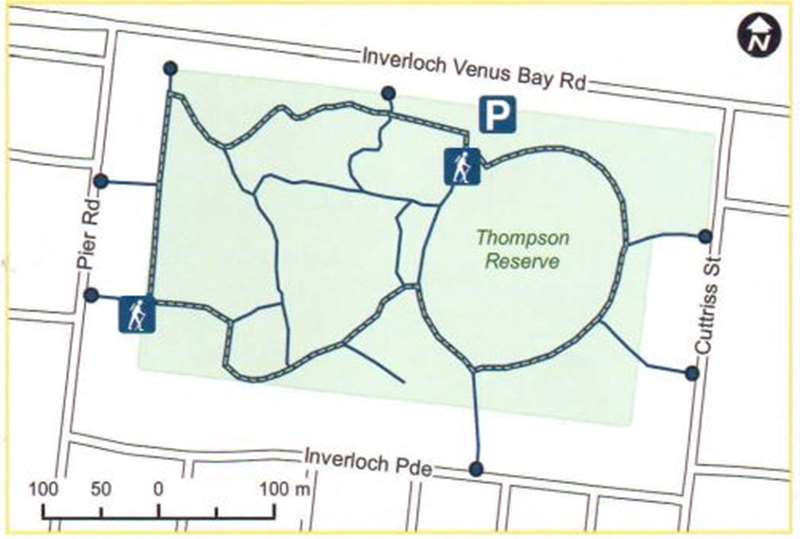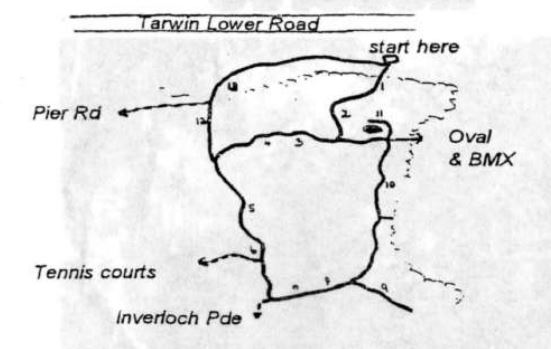Inverloch - Thompson Estate Nature Reserve


Take a stroll through this woodland reserve for a glimpse of what Inverloch looked like before settlement.
This short trail will take you through natural bushland, original woodland and low-lying swamp paperbark thickets that once covered the land where Inverloch now stands. This is a marked nature walk and the South Gippsland Conservation Society pamphlet (available at your local Visitor Information Centre or download link below) corresponds to the pegs along the track to provide information on flora and fauna.

- Length/Time - Loop 2km / 30 minutes walking
- Grading is Easy
- Track surface is dirt and grass
- Car parking (unsealed) at Inverloch-Venus Bay Road and street parking (sealed) in Cuttriss Street and Pier Road.
- No Designated Accessible Parking
- No Toilets
- Prams suitable in some parts of walk but not all
- Bicycles not permitted
- Picnic table
Access for Dogs:
Dogs permitted on a lead.
South Gippsland Conservation Society Guide
This is a patch of natural bushland such as is becoming all too rare near towns today. The walk will introduce you to some of the features of the original woodland and low-lying swamp paperbark thickets, which once covered the land where Inverloch now stands. Please help us protect this area by staying on the tracks, not picking or damaging plants and avoiding revegetation areas.

The marked nature walk takes about 30 minutes. The numbers on the map correspond to the numbered pegs along the track. There is a lot to see, hear and discover, so don't rush for the pegs.
1. The large tussock of long firm grass-like leaves is that of the Spiny-headed Matrush. The name is derived from its mustard-coloured flowers which are enveloped in sharp spines. A widespread plant, it was used by the Aborigines for making dilly-bags, and the base of the leaf formed part of their diet.
2. These two large Native Cherries (Cherry Ballarts) are good examples of the typical pyramid shape of this tree. It is partly parasitic on the roots of other trees, especially eucalypts. The hard fruits (nuts) are borne on swollen fleshy red stalks ("cherries") which were once gathered and eaten by Aborigines. Butterflies feed on the nectar of the small inconspicuous flowers. It thrives alter fire and slashing. It grows from an underground stem called a rhizome, which explains its remarkable resilience.
3. Inverloch's most widespread tree is here represented by two large Messmate Stringybarks. Like other eucalypts called "stringybarks', the Messmate has persistent bark that is fibrous and stringy. Its goblet-shaped fruits appear in large clusters. The inland form of this tree is taller and less spreading than the coastal form.
While looking at individual plants we need to remember that the bushland is a whole community of living things, and all the plants around you have a part to play. The grasses give shelter to animals, the seeds and nectar-rich flowers provide food for birds and other animals, the eucalypts shelter a host of animals and small plants and the soil type and availability of water affect the kinds of plants that will grow. It's all part of the web of living things.
Beginning at this peg, make a point of searching the upper branches of the eucalypts for koalas. It is not true that the koala feeds only on the leaves of the Manna Gum. In fact, they require a varied diet selected from the leaves of a number of eucalypt species. The leaves of all three eucalypts found in this area are used as food by koalas. They consume about one kilogram of leaves a day, so if they are around there should be plenty of evidence. The droppings are dull green and about 2 cm in length. Check around your feet!
4. Look at the plants close to the ground. The understorey, which contains the 90% of plants that are under knee-high, is the most valuable part of the forest in terms of plant diversity. Spring is the best time to see these plants. Their survival strategies include the formation of tubers that survive the summer heat when perennial plants die back, and the production of large numbers of seeds which form seedbeds to replace annuals as they die out each year.
5. Dense, shady Swamp Paperbark thickets like these are still common in swamps and on creek banks around Inverloch. The creamy bottlebrush-type flower Greek words 'melos' meaning black and "leukos' meaning white).
The dark foliage above the pale papery trunks excludes most sunlight, so there are few understorey plants. During the cooler, wetter months of the year however, this moist dark environment offers ideal conditions for non-flowering plants such as ferns, mosses, liverworts and fungi.
The denseness of the Paperbark stands also provides cover for small birds and animals, and ringtail possums.
Look in the foliage above you for an untidy ball of twigs and leaves about 25 cm across. These are the nests where the ringtails sleep during the day. Like many of our native mammals, ringtails are nocturnal. A visit to this area at night for a 'spotlight' walk may introduce you to more of the beautiful wildlife that lives in the bush.
6. This area has been invaded by garden plants which must be seen as weeds, in particular the Sweet Pittosporum which, although native to other parts of Victoria, was not an original inhabitant of Inverloch. Its sweet-smelling creamy flowers develop orange berries which harden and open to expose a mass of very sticky seeds. It is this characteristic which has caused the Sweet Pittosporum to become so widespread, the sticky seeds being carried by the birds which feed on it.
Perhaps you could make a list of all the other weeds you can see alongside the track leading to the tennis courts.
7. Here, where the fertility and moisture level is high, the bush has been invaded by pasture grasses. Their presence here reminds us that the whole of the Thompson Estate was once grazed by cattle.
8. A second kind of eucalypt is emerging from the Swamp Paperbark thickets, the Swamp Gum. Unlike the stringybarks, these gums shed their rough hard bark in ribbons, exposing a smooth grey trunk. The funnel shaped fruits (gumnuts) appear in clusters of three or four. The adult leaves have broadly wavy edges and the juvenile leaves are almost circular. These trees often grow with paperbarks on swampy flats and in poorly drained soils.
9. Look closely at the Eucalypts around you. There are large clusters of leaves on them that do not seem to belong.
These plants growing on the trees are mistletoes. They are parasites, drawing their water and nutrients from the host tree. Sometimes their growth is so profuse that they almost kill their hosts. More often they are kept in check by insects like the Imperial White butterfly, whose caterpillars feed on them. Mistletoe is spread by the Mistletoe bird which eats the fruit and passes the seed through its gut on to a branch where it germinates (other fruit-eating birds shed their droppings on the ground below the trees). The Mistletoe bird is brightly coloured but elusive.
Further along this track is a man-made mound and the ruins of a ramp where cattle were loaded in the days when the Estate was farmed. Later the ramp was used to load horses. When the Estate was acquired by the Woorayl Shire Council it deteriorated from disuse.
10. Notice the change in vegetation at this point, where the land is higher and drier, out of the Paperbark thickets into Messmate/Narrow-leaf Peppermint woodland. The Peppermint is the last of the three eucalypts that occur in this Reserve. It takes its name from the strong odour of the leaves when crushed Notice the oil dots on the leaves.
11. Close your eyes for 30 seconds. Listen for the sounds of the bush life around you. The pool which may dry up in the summer, nevertheless attracts plenty of wildlife. As soon as the water returns it is full of life. Plants like algae appear, quickly followed by the animals which feed on them, insect larvae like the nymph of the Dragonfly, and water fleas, and soon the larger animals like the frogs and birds arrive. The waste products of all these animals fall to the bottom of the pool and are recycled by bacteria and other micro-organisms. The rich food source, the availability of drinking water and the shelter of the bushland, provide a perfect home for our wildlife.
12. Brickmakers' Sedge or Thatch Saw-sedge was used by early brickmakers between layers of bricks in kilns, so they did not stick together. The young leaves from the centre of the plant were used in basket-making by the Aborigines. It is also a butterfly food plant.
13. You are now in a native grassland area where the Kangaroo grass is dominant. Other plants which grow out here are sun-lovers like the sun orchids, onion orchids, chocolate lilies, wild irises (or flag lilies), milkmaids and, where the ground is damp, the swamp Goodenia. Spring is the time to see them.
This is the end of the marked track. The path through the grass will take you back to the starting point.
Note: This guide has been prepared by the Inverloch Branch of the South Gippsland Conservation Society.
Review:
The best place to park is along Inverloch-Venus Bay Road where there is a small car parking area and an entrance to the bushland area. We had trouble finding any marker pegs along the route and had some difficulty following the map. There are some seats for a rest.
Photos:
Location
Cnr Inverloch-Venus Bay Road and Cuttriss Street, Inverloch 3996 View Map
Web Links
→ Thompson Reserve Pamphlet (South Gippsland Conservation Society)








